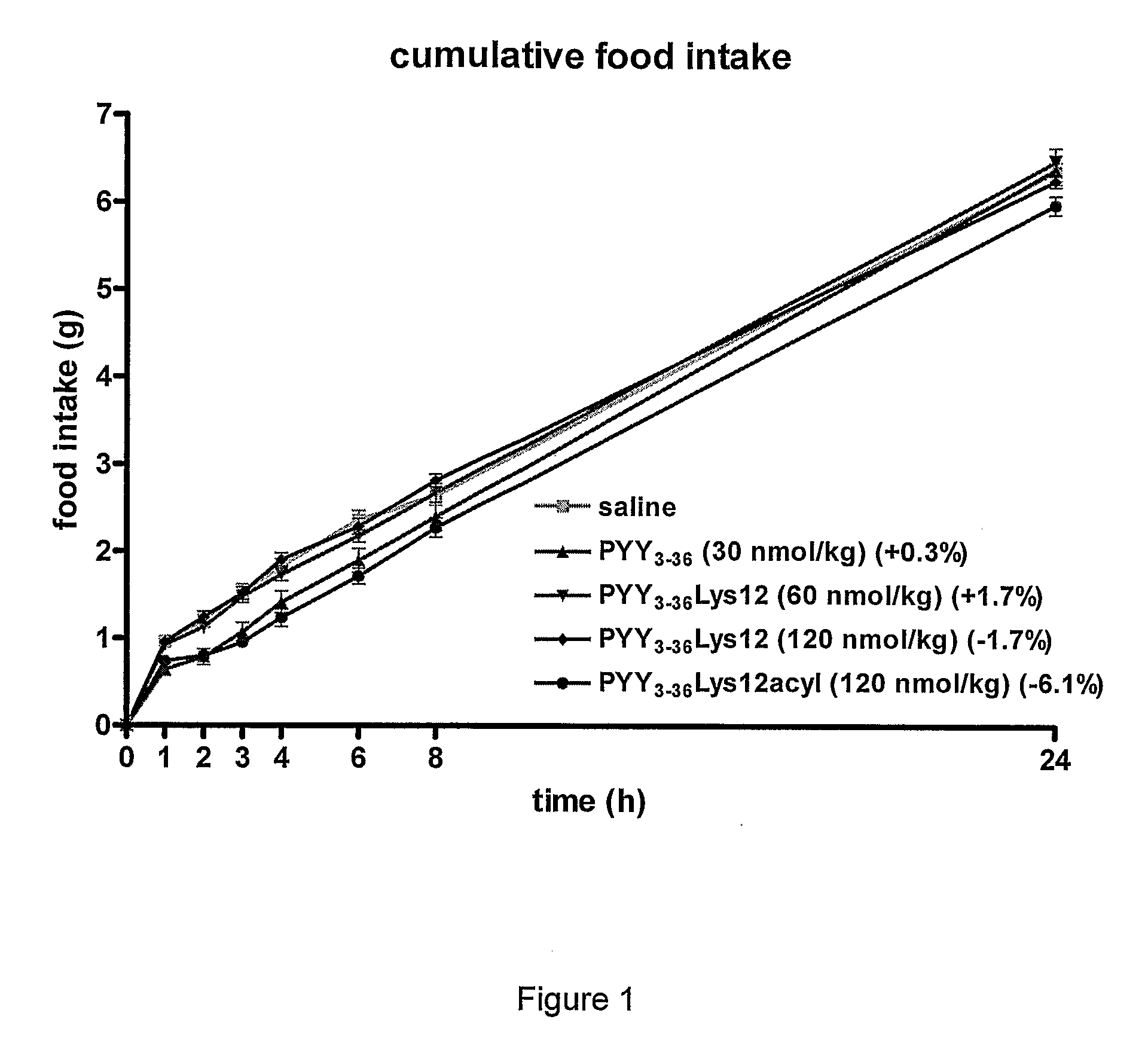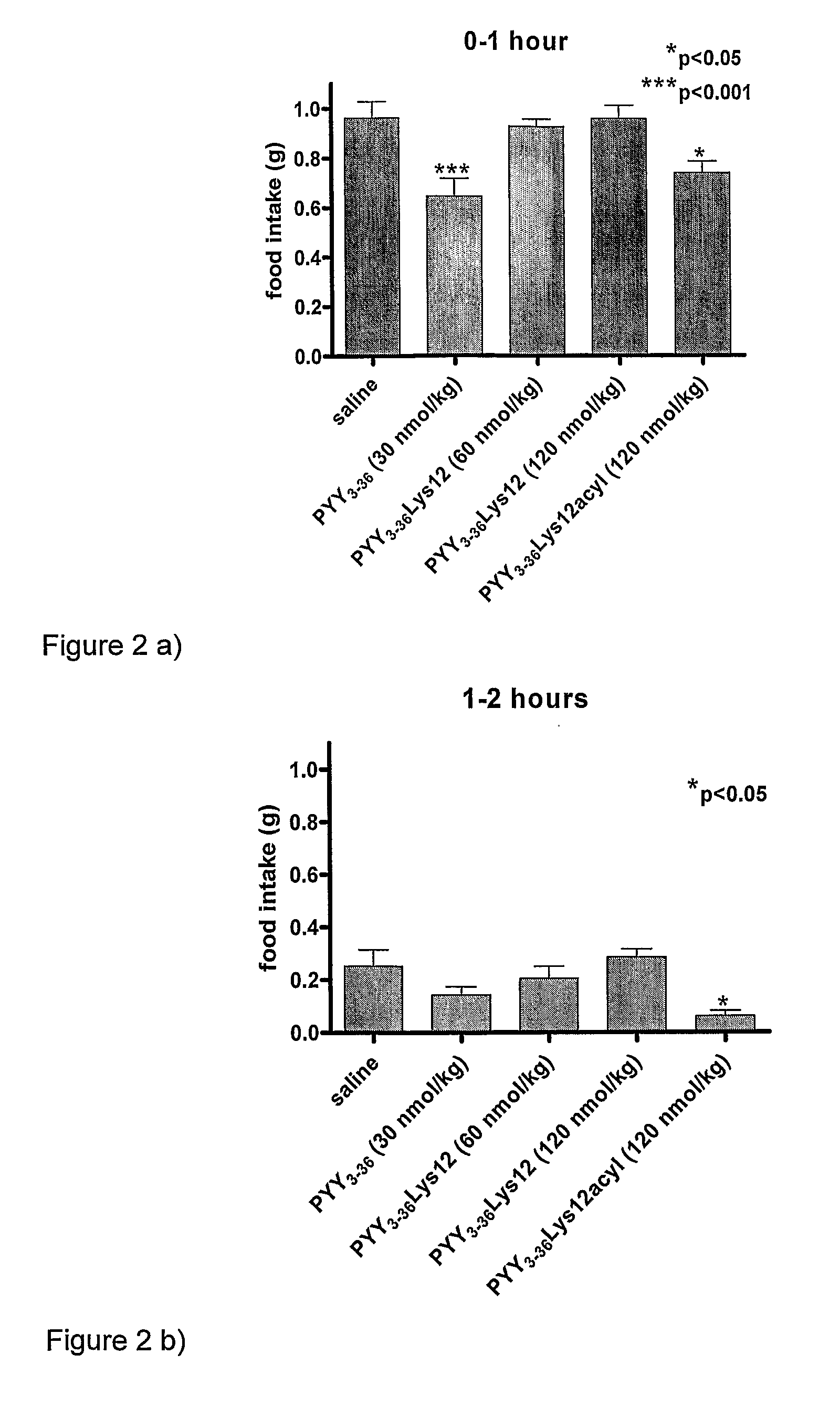Novel compounds and their effects on feeding behaviour
a technology of compound and compound, applied in the field of obesity, can solve the problems of complex and multi-factorial obesity, large percentage of overweight or obese children in the united states, and association with obesity
- Summary
- Abstract
- Description
- Claims
- Application Information
AI Technical Summary
Benefits of technology
Problems solved by technology
Method used
Image
Examples
example 1
Administration of 3 Different PYY Analogues to Mice
[0102]The effects of PYY3-36 (at 30 nmol / kg) (SEQ ID NO:2), PYY3-36Lys12 (at two dosages—60 nmol / kg and 120 nmol / kg) (SEQ ID NO:13), and PYY3-36Lys12Lauryl (at 120 nmol / kg) (SEQ ID NO: 14), were compared after a single injection. A control of saline was used.
[0103]The results are shown in the graph of FIG. 1, in the time-interval bar charts of FIGS. 2a) to 2g) and in the comparative graph of FIG. 3. In the figures, PYY3-36Lys12Lauryl is named PYY3-36Lys12Acyl. As is seen in the Figures, PYY3-36Lys12Lauryl had a similar decreasing effect on food intake as PYY3-36 until 8 hours. As is seen particularly in the FIG. 1 graph showing cumulative food intake, the effect of PYY3-36 was lost after 8 hours and by 24 hours, the cumulative food intake for the 24 hour period of mice given PYY3-36 was essentially the same as those given the saline control. That is to say that the initial decrease in food intake was compensated for by an increase i...
example 2
Dose Response Experiment for PYY3-36Lys12Lauryl in Mice
[0105]The effects of PYY3-36Lys12Lauryl (at three dosages—60 nmol / kg, 120 nmol / kg and 240 nmol / kg) were compared with PYY3-36 (at 30 nmol / kg) after a single injection. A control of saline was used.
[0106]The results are shown in the time-interval bar charts of FIGS. 4a) to 4g) and in the comparative graph of FIG. 5. The results at the 1 hour, 2 hour and 3 hour time point (ie the amounts of food consumed in the first hour, the second hour and the third hour) show a does-response relationship, with 240 nmol / kg PYY3-36Lys12Lauryl achieving a greater effect than 120 nmol / kg, and both showing a greater effect than 60 nmol / kg. At all doses, the effects of PYY3-36 and PYY3-36Lys12Lauryl wears off after a time and, as seen in FIG. 5, eventually the food intake becomes greater (in a given time period) in the mice that had received the PYY3-36 and PYY3-36Lys12Lauryl than in the saline control mice. The time at which that occurs is later fo...
PUM
| Property | Measurement | Unit |
|---|---|---|
| Fraction | aaaaa | aaaaa |
| Composition | aaaaa | aaaaa |
Abstract
Description
Claims
Application Information
 Login to View More
Login to View More - R&D
- Intellectual Property
- Life Sciences
- Materials
- Tech Scout
- Unparalleled Data Quality
- Higher Quality Content
- 60% Fewer Hallucinations
Browse by: Latest US Patents, China's latest patents, Technical Efficacy Thesaurus, Application Domain, Technology Topic, Popular Technical Reports.
© 2025 PatSnap. All rights reserved.Legal|Privacy policy|Modern Slavery Act Transparency Statement|Sitemap|About US| Contact US: help@patsnap.com



